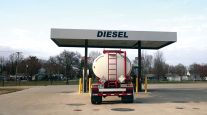Diesel Rises 3.5¢ to $3.197
This story appears in the Dec. 13 print edition of Transport Topics.
U.S. retail fuel prices jumped last week, reversing declines over the past two weeks, as the average cost of a gallon of diesel rose 3.5 cents to reach $3.197, the U.S. Department of Energy reported.
The gasoline average, meanwhile, reached a two-year high, surging 10.2 cents to $2.958 a gallon, DOE said after its Dec. 6 survey of filling stations. Crude oil also hit a two-year high last week.
“Crude is edging towards $90 a barrel, and that is having some influence on diesel,” Roger McKnight, senior petroleum analyst with En-Pro International, told Transport Topics Dec. 8. Also, some investors are flocking back to oil markets to hedge against the dollar, he said, so rising crude prices have “artificially dragged along” diesel and gasoline.
The diesel increase easily wiped out a cumulative drop of 1.39 cents over the prior two weeks. The most recent price is 42.5 cents a gallon higher than in the corresponding week of 2009.
The increase for gasoline was the steepest since May 2009, and erased a decline of 3.6 cents during the prior two weeks. Year-over-year, gas is up 32.4 cents a gallon.
For four weeks, the diesel average has hovered at levels not seen since October 2008, when prices were winding down after the burst of a commodities bubble that drove diesel to around $5 a gallon in some parts of the nation.
During the bubble, petroleum market experts said diesel prices were no longer driven only by the fundamentals of supply and demand.
Last week, McKnight said that situation is recurring. He said he used to parse DOE’s weekly data to help craft fuel-purchasing strategies, but “in the last four weeks, I’ve given up on doing it” because prices aren’t following supply and demand. “I guess the speculators are going to get involved here.”
DOE’s Energy Information Administration said in its latest weekly petroleum report that rising fuel prices reflect the slowly reheating global economy, which is stoking demand and shrinking supply.
Moreover, “transportation fuels, in general, appear to be driving total demand growth at a very strong pace,” DOE said.
The executive in charge of fuel purchasing for one carrier leaned toward McKnight’s view.
“We used to buy futures” to guard against price-swings, said Brad Vander Steo, controller of truckload carrier Van Eernden Trucking, Byron Center. Mich. “But we haven’t done that for years. There’s so much speculation in the market that it’s just kind of a crapshoot.”
Today, Van Eernden’s hedges against higher fuel bills are its drivers and fuel-saving equipment for its trucks.
“We have battery-powered [auxiliary power units], which cut our idle time,” Vander Steo told TT Dec. 8. “We’ve also outfitted most of our trailers with trailer skirts [and] set the truck speeds to 68 mph.”
As a result, the carrier saves about $1 million a year on fuel, Vander Steo said.
Two other carriers also described benefits they have reaped from APUs and lower speeds.
“We figure at the cost of fuel today, we’re saving about $150 per week, per truck, minimum” with APUs, said Rick Robinson, president of truckload carrier Robinson Transport, Columbus, Ohio. Robinson runs 160 trucks.
In addition, “We set the speed at 62 mph on the pedal and 65 mph on cruise control,” Robinson said. “Any reputable carrier today that’s successful and is going to survive” is governing truck speed. “The drivers have pretty much accepted it,” he said.
However, another executive said that some drivers are still sensitive enough to their per-mile pay that he had to gradually phase in speed governors.
“You want to save on fuel, but you don’t want the drivers to go someplace else to work,” said Kenny Pellegrino, CEO of Transport Services Inc. of Romulus, Mich.
Transport Services trucks are governed at 65 mph at the pedal and 69 mph on cruise control, Pellegrino told TT. He said that every 10 mph increase in speed beyond 60 mph burns an additional gallon of diesel per mile.
“We would like to reduce it further to enjoy more savings, but have to weigh the driver-retention issues,” Pellegrino said.
DOE’s latest inventory report revealed that while demand for diesel has not yet returned to pre-recession levels, it is indeed rising. The same report showed that U.S. supplies are being drawn down.
Demand for distillate fuel — the category that includes diesel — rose to 3.664 million barrels a day for the week ended Dec. 3, up from 3.32 million barrels a day a year before. Distillate stockpiles in the same period fell to 160.2 million barrels from 167.3 million barrels.
Crude oil on Dec. 6 closed at $89.38 a barrel, the highest close since October 2008, according to Bloomberg News.




